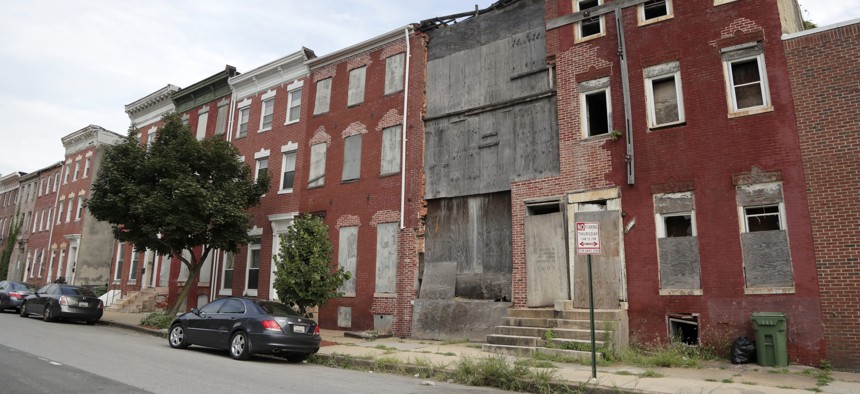Opportunity Zones Investors Show Appetite for Real Estate Over Startups

Boards cover the front end of a abandoned row homes in the vicinity of an opportunity zone in Baltimore. (AP Photo/Julio Cortez)
Nearly three quarters of $4.5 billion that has poured into the program is in investment funds that plan to focus at least in part on residential real estate.
Opportunity Zones investors appear more eager to back real estate development than provide capital for local businesses and entrepreneurial ventures, based on new figures that show where money is flowing under the federal economic development program.
Accounting and consulting firm Novogradac on Tuesday provided updated information on 366 “opportunity funds” it is tracking. These funds are planning to invest in areas around the U.S. that are eligible for the economic development initiative.
The company’s release does not offer a complete picture of the opportunity fund landscape. It only includes data on a selection of funds that are raising money from third party investors. So, for example, a corporation starting a fund to invest its own capital gains would not be included.
Even so, the figures provide some strong indications about how the funds are taking shape. Among the 366 funds, 184 funds have reported raising a combined sum of nearly $4.5 billion. Almost half of that total, about $2.1 billion, is concentrated in just a dozen larger funds.
Much of the investment that has flowed into the funds has occurred in the last 12 to 15 months, according to Novogradac’s managing partner Michael Novogradac. “We’re excited to see the level of capital that they’ve raised,” he said by phone on Monday. “The pace is picking up.”
A sizable share of the capital that’s been raised—about $3.3 billion, or roughly three quarters of the $4.5 billion total—is in funds with at least a partial focus on residential real estate. Commercial real estate is at least a partial focus for funds that have raised 69% of the total.
In contrast, only 3.2%, or $141 million, of the total dollar amount raised went toward funds that are focused entirely or partly on non-real-estate business ventures—often called “operating businesses” in the parlance of the program.
This finding is notable because proponents of the program have said it could be a boon for helping start-ups and other businesses in areas that have historically lacked access to capital.
Critics on the other hand have charged that money is flowing to real estate deals in areas that are safer bets and that may have attracted investment even without a tax break.
The release also examined which cities are getting the most interest from Opportunity Zones investors.
Here the firm looks at the sums raised by funds that plan to target specific cities. New York City and Los Angeles lead the pack. But the next cities on this list are smaller in size and away from the coasts—St. Louis, Indianapolis, Nashville, and St. Paul, Minnesota.
Funds targeting these places and 14 other cities have raised at least $10 million each.
But funds with a nationwide focus raised nearly $1.8 billion, or about 45% of the recorded total, while single-city funds raised $778 million.
Novogradac highlighted some likely reasons that funds focused on real estate are attracting greater amounts of money.
One is that real estate tends to be less risky than other business ventures. Another is that it can absorb greater volumes of equity investments like those that the funds offer. Lastly, Treasury Department rules for investing in non-real-estate ventures have been slower to come into focus.
Novogradac also pointed out that if funds invest in commercial real estate in distressed communities that could pave the way for new business activity in those places.
The Opportunity Zones initiative was created as part of the 2017 federal tax code rewrite. It offers tax breaks to people and companies that reinvest capital gains in opportunity funds.
These funds are supposed to then invest that money in business and real estate projects in and around economically distressed communities. The areas eligible for investment under the program include about 8,700 census tracts that are located across the country.
To maximize the tax breaks that the program offers, investors would need to put their money into opportunity funds by Dec. 31. The Novogradac release says the firm expects there to be a flurry of additional investment activity before the end of the year.
The $4.5 billion raised by the funds Novogradac is tracking marks a 40% increase from the company’s last report, which was issued about 50 days ago.
Estimates the congressional Joint Committee on Taxation released around the time the 2017 federal tax bill was passed indicate that the Opportunity Zones program will cost the federal government about $1.6 billion between 2018 and 2027.
To help put these amounts in perspective, in fiscal year 2019 the federal government allocated about $3.3 billion for Community Development Block Grants, a program popular with local government leaders that is used to fund infrastructure projects, housing and other initiatives.
Bill Lucia is a Senior Reporter for Route Fifty and is based in Olympia, Washington.

NEXT STORY: Republican Lawmaker in Florida Wants Undocumented Immigrants to Get Driver’s Licenses






